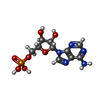+Search query
-Structure paper
| Title | Structure of an AMPK complex in an inactive, ATP-bound state. |
|---|---|
| Journal, issue, pages | Science, Vol. 373, Issue 6553, Page 413-419, Year 2021 |
| Publish date | Jul 23, 2021 |
 Authors Authors | Yan Yan / Somnath Mukherjee / Kaleeckal G Harikumar / Timothy S Strutzenberg / X Edward Zhou / Kelly Suino-Powell / Ting-Hai Xu / Ryan D Sheldon / Jared Lamp / Joseph S Brunzelle / Katarzyna Radziwon / Abigail Ellis / Scott J Novick / Irving E Vega / Russell G Jones / Laurence J Miller / H Eric Xu / Patrick R Griffin / Anthony A Kossiakoff / Karsten Melcher /   |
| PubMed Abstract | Adenosine monophosphate (AMP)-activated protein kinase (AMPK) regulates metabolism in response to the cellular energy states. Under energy stress, AMP stabilizes the active AMPK conformation, in ...Adenosine monophosphate (AMP)-activated protein kinase (AMPK) regulates metabolism in response to the cellular energy states. Under energy stress, AMP stabilizes the active AMPK conformation, in which the kinase activation loop (AL) is protected from protein phosphatases, thus keeping the AL in its active, phosphorylated state. At low AMP:ATP (adenosine triphosphate) ratios, ATP inhibits AMPK by increasing AL dynamics and accessibility. We developed conformation-specific antibodies to trap ATP-bound AMPK in a fully inactive, dynamic state and determined its structure at 3.5-angstrom resolution using cryo-electron microscopy. A 180° rotation and 100-angstrom displacement of the kinase domain fully exposes the AL. On the basis of the structure and supporting biophysical data, we propose a multistep mechanism explaining how adenine nucleotides and pharmacological agonists modulate AMPK activity by altering AL phosphorylation and accessibility. |
 External links External links |  Science / Science /  PubMed:34437114 / PubMed:34437114 /  PubMed Central PubMed Central |
| Methods | EM (single particle) / X-ray diffraction |
| Resolution | 3.47 - 5.5 Å |
| Structure data | EMDB-22336, PDB-7jhg: EMDB-22337, PDB-7jhh: EMDB-23708, PDB-7m74:  PDB-7jij: |
| Chemicals |  ChemComp-TAK:  ChemComp-ATP:  ChemComp-ADP:  ChemComp-AMP: |
| Source |
|
 Keywords Keywords | TRANSFERASE/IMMUNE SYSTEM / AMPK / ATP / fully inactive / KD-displaced / TRANSFERASE-IMMUNE SYSTEM complex / SIGNALING PROTEIN / activation / ATP-binding |
 Movie
Movie Controller
Controller Structure viewers
Structure viewers About Yorodumi Papers
About Yorodumi Papers









 homo sapiens (human)
homo sapiens (human)

